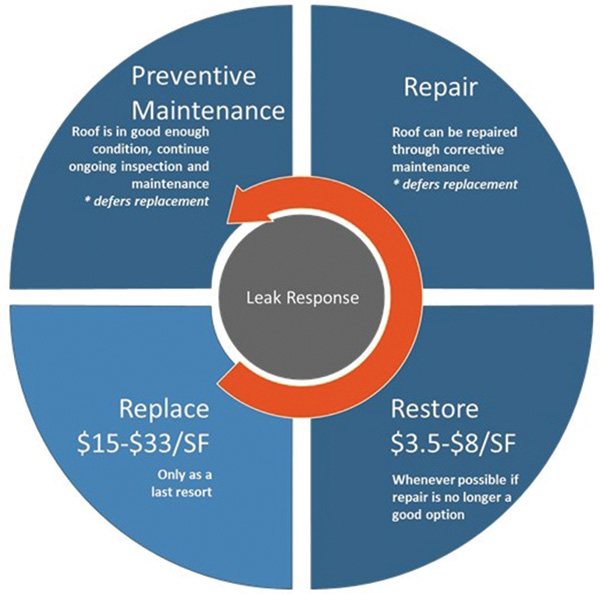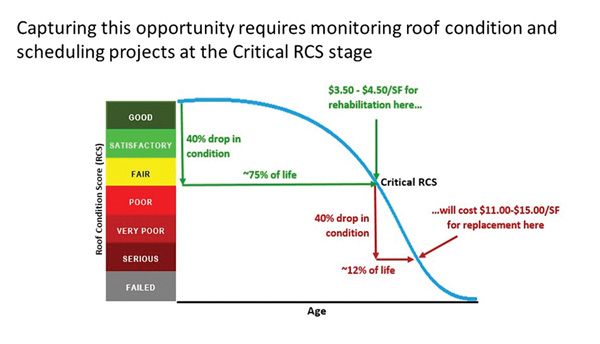— By Richard Rast, BLUEFIN, LLC —
Why roof preservation matters for retail and restaurant industries and the best solution to preserve roof life.
Is your facility or building property protected from weather and unintended abuse threatening its roof? When a roof is neglected, human-caused and environmental elements can lead to premature commercial roof failure. Since roofs are often out of sight and out of mind, roofs are not a priority until an emergency happens. Proactive management can minimize the impact of premature roof failure, improve reliability and save money.
 Proactive roof management allows companies to confront the consequences of four common roofing issues:
Proactive roof management allows companies to confront the consequences of four common roofing issues:
1. Customer Experience: A leaking roof reflects poorly on your image and sends a bad message to your customers, possibly resulting in lost business.
2. Safety Incidents: Water intrusion can cause safety and health incidents. This includes wet floors leading to customer and employee slips and falls and potential contamination risk.
3. Operational Disruptions: Rainwater can damage inventory and valuable equipment. A leaky roof can also cause operational delays and disrupt an efficient workflow.
4. Budget Emergencies: An unanticipated roof failure can completely drain your capital budget, which means that other critical projects are deferred.

Richard Rast, BLUEFIN, LLC
These issues are unacceptable for companies who rely on weather-tight buildings.
A proactive roof asset management program will break this expensive reactionary cycle. Roof asset management will:
- Find and prevent leaks before customers and employees are harmed and equipment and inventory is damaged.
- Maintain the roof to a high-performing level.
- Extend the service life of existing roofs.
- Meet warranty requirements to keep coverage.
- Prevent unanticipated and unnecessary spending and stress.
- Result in the lowest total cost of ownership for your roof assets now and in the future.
Many roof management approaches exist. An approach that delivers roof reliability and cost savings across a large facility portfolio would likely have six components:
- Data Management & Planning
The documentation and data of the roof assets combined with expert insight builds a strategic plan for roof management over the lifetime of the roof.
- Emergency Response
A quick response to roofing issues is critical, especially with emergency leaks. It is also important to make sure repairs are permanent and part of a strategic plan. Take caution of suggested temporary fixes as this is usually short-sighted thinking.
- Preventive Maintenance
Property owners and building managers are responsible for roof maintenance. This step is important to preserve the life of the roofs and keep warranty coverage.
Every person maintains the roof system in their own way, and each contractor builds a roof system differently. Therefore, all roofs have a unique life cycle and uniquely age.
However, when any roof reaches mid-life, it exponentially degrades to a point where no repair or restoration can fix it. You can prolong this predictable decline and reduce future replacement costs through regular preventive maintenance.
- Repairs
A best practice in roof asset management is to identify repairs as you perform preventive maintenance and perform annual roof inspections. The next step is to prioritize repairs based on need and schedule this work annually. Scheduling repairs on an annual proactive basis not only extends roof life, but the cost of repairs is much lower versus a reactive leak-driven repair.
- Roof Restoration
 Roof restoration, also known as rehabilitation, is the long term restoration and life extension of the roof system. Examples include overlays, fluid-applied membranes, major repairs of flashings and other roof system components. The intent of restoration is to significantly extend the life of the roof, usually by 5 to 10 years or more, at a fraction of the cost of a total roof replacement. The key is to identify and implement a restoration strategy before the roof deteriorates to the point that the only option is a full-depth replacement. This includes inspecting the roof, performing moisture tests and potentially other tests to determine whether the base roof is adequate for restoration.
Roof restoration, also known as rehabilitation, is the long term restoration and life extension of the roof system. Examples include overlays, fluid-applied membranes, major repairs of flashings and other roof system components. The intent of restoration is to significantly extend the life of the roof, usually by 5 to 10 years or more, at a fraction of the cost of a total roof replacement. The key is to identify and implement a restoration strategy before the roof deteriorates to the point that the only option is a full-depth replacement. This includes inspecting the roof, performing moisture tests and potentially other tests to determine whether the base roof is adequate for restoration.
- Roof Replacement
A qualified roof consultant can predict when a facility needs a roof replacement based on the components in the roof management program. They will create a guide for a smooth year-over-year spending, which is favorable since the cost of replacements runs high.
Regardless if your building is a new state-of-the-art or an aging facility, excellent roof performance should be a goal for all facilities and buildings. If that becomes your goal, look for an asset management program containing these six components to prevent degradation, reduce leaks and, consequently, reduce future costs and gain budget continuity.
Consider this success story from a casual dining restaurant chain with over 1,100 restaurants throughout North America. Roof management played a critical role in reducing food contamination, customer safety risks and budget surprises. Additionally, the roof management program achieved roof reliability while reducing both operating expenses and capital spending.
The restaurant company suffered from an aging building inventory and uncertainty about conditions due to rapid growth that was driven by expansion. As a result, they had extensive roof leaks, prematurely failing roofs and unanticipated budget surprises.
The company implemented a comprehensive roof asset management program and over the course of 4 years achieved cost savings, budget management and roof reliability to prevent production impact.
- Roof Life Extension: The average function roof life for this portfolio was 12 years when this program began. Factors impacting roof life include extensive on the roof maintenance for HVAC and refrigeration equipment and animal fats discharged on the roof from cooking operations. Proactive measures were implemented to protect and preserve the roof systems and average life has been extended to slightly above 16 years now.
- Cost Savings: The restaurant company established a baseline budget for proactive roof management in 2011. This proactive scenario identified over $3 million per year in annual cost savings (capital and expense) versus its “status quo” scenario. It did this by using maintenance, rehabilitation and restoration to extend roof service life.
- Budget Management: Annual budget management is an indication of how the approved budgets are managed. In the instance of its capital roof program, actual expenses have consistently been below budget. This has occurred through aggressive value engineering and project management.
- Roof Reliability: A Roof Condition Score (RCS) is a tool to determine the high-level indication of overall roof condition. RCS factors in the physical condition of the roof system, the leak history and the estimated remaining service life. This is a key indicator of overall roof condition and future performance. In 2011 the average weighted RCS for the entire portfolio was 58. Today it is nearly 73. This is a remarkable improvement, particularly since capital spending is under budget.
- Operating Impacts: Leaks have dropped by 75%.
- Safety: The company has not had a single recordable incident in the performance of roofing service nor have there been recordable safety incidents with any roofing contractor since implementing the roof asset management program.
Each retail and restaurant facility is different, but facilities have the potential to see on average a 25% to 30% reduction in roof expenditures and a 50% to 75% reduction in leaks and associated damage through proactive roof asset management.
— Richard Rast is president and founder of BLUEFIN, LLC, a premier consulting company for commercial roof, pavement and building envelope management. Based in Denver with offices throughout the U.S., BLUEFIN helps large building owners preserve their highest-value facility asset. For more information, visit www.bluefinllc.com.
